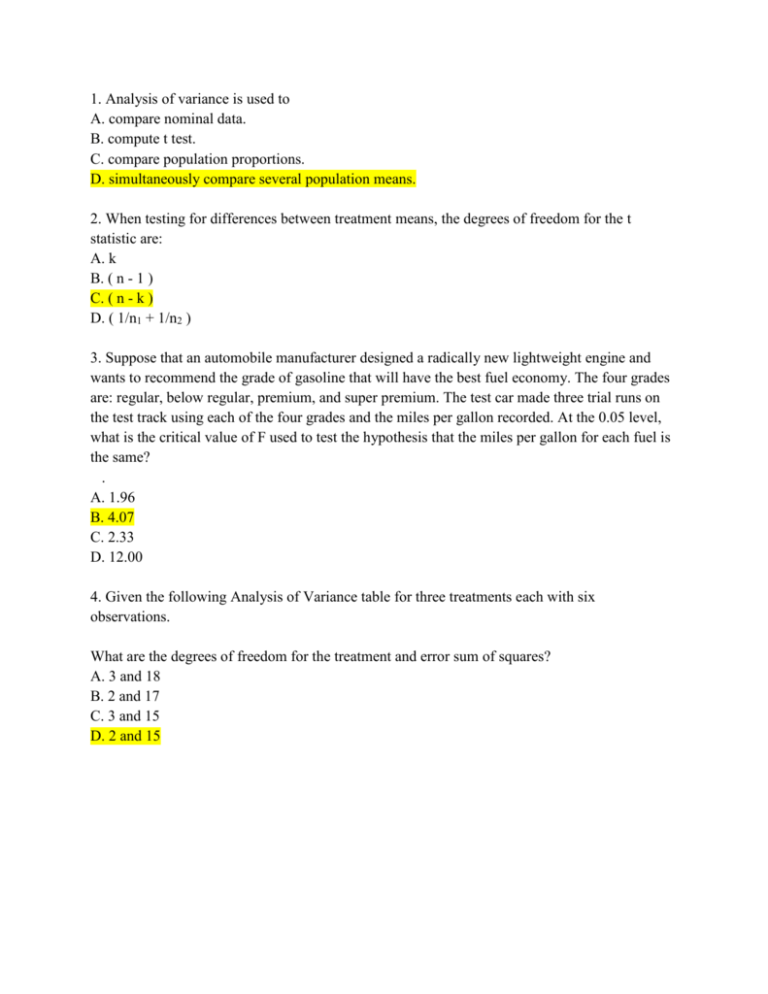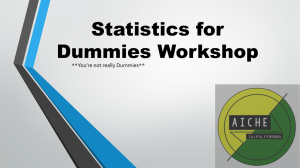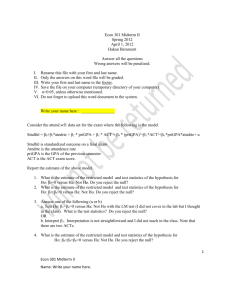1. Analysis of variance is used to A. compare nominal data. B
advertisement

1. Analysis of variance is used to A. compare nominal data. B. compute t test. C. compare population proportions. D. simultaneously compare several population means. 2. When testing for differences between treatment means, the degrees of freedom for the t statistic are: A. k B. ( n - 1 ) C. ( n - k ) D. ( 1/n1 + 1/n2 ) 3. Suppose that an automobile manufacturer designed a radically new lightweight engine and wants to recommend the grade of gasoline that will have the best fuel economy. The four grades are: regular, below regular, premium, and super premium. The test car made three trial runs on the test track using each of the four grades and the miles per gallon recorded. At the 0.05 level, what is the critical value of F used to test the hypothesis that the miles per gallon for each fuel is the same? . A. 1.96 B. 4.07 C. 2.33 D. 12.00 4. Given the following Analysis of Variance table for three treatments each with six observations. What are the degrees of freedom for the treatment and error sum of squares? A. 3 and 18 B. 2 and 17 C. 3 and 15 D. 2 and 15 5. Two accounting professors decided to compare the variance of their grading procedures. To accomplish this they each graded the same 10 exams with the following results: At the 1% level of significance, what is the decision? A. Reject the null hypothesis and conclude the variance is different. B. Fail to reject the null hypothesis and conclude the variance is different. C. Reject the null hypothesis and conclude the variance is the same. D. Fail to reject the null hypothesis and conclude the variance is the same. 6. An electronics company wants to compare the quality of their cell phones to the cell phones from three competitors. They sample 10 phones from each company and count the number of defects for each phone. If ANOVA were used to compare the average number of defects, the treatments would be defined as: A. The number of cell phones sampled. B. The average number of defects. C. The total number of phones. D. The four companies. 7. Two accounting professors decided to compare the variance of their grading procedures. To accomplish this they each graded the same 10 exams with the following results: At the 5% level of significance, what is the decision regarding the null hypothesis? A. Reject the null hypothesis and conclude the variance is different. B. Fail to reject the null hypothesis and conclude no significant difference in the variance. C. Reject the null hypothesis and conclude the variance is the same. D. Fail to reject the null hypothesis and conclude the variance is the same. 8. A random sample of 16 companies was selected and asked for their annual dividend rate in three different industries: utilities, banking, and insurance. The ANOVA comparing the mean annual dividend rate among three industries rejected the null hypothesis. The Mean Square Error (MSE) was 3.36. The following table summarized the results: Based on the comparison between the mean annual dividend for companies in the utilities and insurance industries, A. A confidence interval shows that the mean annual dividend rates are not significantly different. B. The ANOVA results show that the mean annual dividend rates are significantly different. C. A confidence interval shows that the mean annual dividend rates are significantly different. D. The ANOVA results show that the mean annual dividend rates are not significantly different. 9. Given the following Analysis of Variance table for three treatments each with six observations. What is the decision regarding the null hypothesis? A. Reject H0 - there is a difference in treatment means B. Fail to reject H0 - there is a difference in treatment means C. Reject H0 - there is a difference in errors D. Fail to reject H0 - there is a difference in error 10. Several employees have submitted different methods of assembling a subassembly. Sample data for each method are: How many treatments are there? A. 3 B. 4 C. 12 D. 0 11. Three different fertilizers were applied to a field of celery. In computing F, how many degrees of freedom are there in the numerator? A. 0 B. 1 C. 2 D. 3 12. The null hypothesis for an ANOVA analysis comparing four treatment means is rejected. The four sample means are: 1= 10, 2=12, 3= 15, 4=18. The sample size for each treatment is the same. If ( 1- 2) if significantly different from zero, then A. 1is significantly less than 2, 3, and 4. B. 2is significantly less than 3 and 4. C. 3 and 4 are significantly different. D. 1 2, 3, and 4 are all equal. 13. A manufacturer of automobile transmissions uses three different processes. Management ordered a study of the production costs to see if there is a difference among the three processes. A summary of the findings is shown below. What is the mean square for treatments? A. 2.511 B. 2.151 C. 33.9 D. 29.035 14. A manufacturer of automobile transmissions uses three different processes. Management ordered a study of the production costs to see if there is a difference among the three processes. A summary of the findings is shown below. What is the critical value of F at the 5% level of significance? A. 19.45 B. 3.00 C. 3.35 D. 3.39 15. Two accounting professors decided to compare the variance of their grading procedures. To accomplish this they each graded the same 10 exams with the following results: What are the degrees of freedom for the numerator of the F ratio? A. 8 B. 9 C. 10 D. 18 E. 20 16. A random sample of 30 executives from companies with assets over $1 million was selected and asked for their annual income and level of education. The ANOVA comparing the average income among three levels of education rejected the null hypothesis. The Mean Square Error (MSE) was 243.7. The following table summarized the results: When comparing the mean annual incomes for executives with Undergraduate and Master's Degree or more, the following 95% confidence interval can be constructed: A. 2.0 ± 2.052 * 6.51 B. 2.0 ± 3.182 * 6.51 C. 2.0 ± 2.052 * 42.46 D. 2.0 ± 3.182 * 42.46 17. A random sample of 16 companies was selected and asked for their annual dividend rate in three different industries: utilities, banking, and insurance. The ANOVA comparing the mean annual dividend rate among three industries rejected the null hypothesis. The Mean Square Error (MSE) was 3.36. The following table summarized the results: Based on the comparison between the mean annual dividend rate for companies in the utilities and banking, the 95% confidence interval shows an interval of 1.28 to 6.28 for the difference. This result indicates that A. There is no significant difference between the two rates. B. The interval contains a difference of 5.00. C. The annual dividend rate in the utilities industry is significantly less than the annual dividend rate in banking industry. D. The annual dividend rate in banking industry is significantly less than the annual dividend rate in utilities industry. 18. When testing for differences between treatment means, a confidence interval is based on A. the mean square error. B. the standard deviation. C. the sum of squared errors. D. the standard error of the mean. 19. A preliminary study of hourly wages paid to unskilled employees in three metropolitan areas was conducted. Seven employees were included from Area A, 9 from Area B and 12 from Area C. The test statistic was computed to be 4.91. What can we conclude at the 0.05 level? A. Mean hourly wages of unskilled employees all areas are equal B. Mean hourly wages in at least 2 metropolitan areas are different C. More degrees of freedom are needed D. None of these is correct 20. A large department store examined a sample of the 18 credit card sales and recorded the amounts charged for each of three types of credit cards: MasterCard, Visa and Discover. Six MasterCard sales, seven Visa and five Discover sales were recorded. The store used an ANOVA to test if the mean sales for each credit card were equal. What are the degrees of freedom for the F statistic? A. 18 in the numerator, 3 in the denominator B. 3 in the numerator, 18 in the denominator C. 2 in the numerator, 15 in the denominator D. 6 in the numerator, 15 in the denominator 21. Two accounting professors decided to compare the variance of their grading procedures. To accomplish this they each graded the same 10 exams with the following results: What are the degrees of freedom for the denominator of the F ratio? A. 20 B. 18 C. 10 D. 9 E. 8 22. A random sample of 40 companies with assets over $10 million was selected and asked for their annual computer technology expense and industry. The ANOVA comparing the average computer technology expense among three industries rejected the null hypothesis. The Mean Square Error (MSE) was 195. The following table summarized the results: Based on the comparison between the mean computer technology expense for companies in the Education and Tax services industries, A. A confidence interval shows that the mean annual computer technology expenses are not significantly different. B. The ANOVA results show that the mean annual computer technology expenses are significantly different. C. A confidence interval shows that the mean annual computer technology expenses are significantly different. D. The ANOVA results show that the mean annual computer technology expenses are not significantly different. 23. A manufacturer of automobile transmissions uses three different processes. Management ordered a study of the production costs to see if there is a difference among the three processes. A summary of the findings is shown below. What is the critical value of F at the 1% level of significance? A. 99.46 B. 5.49 C. 5.39 D. 4.61 24. When testing for differences between treatment means, the t statistic is based on: A. The treatment degrees of freedom. B. The total degrees of freedom. C. The error degrees of freedom. D. The ratio of treatment and error degrees of freedom. 25. A manufacturer of automobile transmissions uses three different processes. Management ordered a study of the production costs to see if there is a difference among the three processes. A summary of the findings is shown below. What is the decision? A. Reject H0 - there is a difference in treatment means B. Fail to reject H0 - there is a difference in treatment means C. Reject H0 - there is a difference in errors D. Fail to reject H0 - there is a difference in errors 26. An experiment to determine the most effective way to teach safety principles applied four different teaching methods. Some employees were given programmed instruction booklets and worked through the course at their own pace. Other employees attended lectures. A third group watched a television presentation, and a fourth group was divided into small discussion groups. A high of 10 was possible. A sample of five tests was selected from each group. The test grade results were: At the 0.01 level, what is the critical value? A. 1.00 B. 1.96 C. 3.24 D. 5.29 27. A manufacturer of automobile transmissions uses three different processes. Management ordered a study of the production costs to see if there is a difference among the three processes. A summary of the findings is shown below. What are the degrees of freedom for the error sum of squares? A. 3 B. 10 C. 27 D. 30 28. In ANOVA analysis, when the null hypothesis is rejected, we can test for differences between treatment means by A. constructing confidence intervals. B. adding another treatment. C. doing an additional ANOVA. D. doing a t test. 29. Given the following Analysis of Variance table for three treatments each with six observations. What is the mean square for treatments? A. 71.2 B. 71.4 C. 558 D. 534 30. In ANOVA, an F statistic is used to test a null hypothesis such as: A. Option A B. Option B C. Option C D. Option D









